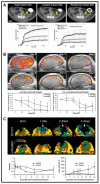Non-invasive imaging for studying anti-angiogenic therapy effects
- PMID: 23407722
- PMCID: PMC3810587
- DOI: 10.1160/TH12-10-0721
Non-invasive imaging for studying anti-angiogenic therapy effects
Abstract
Noninvasive imaging plays an emerging role in preclinical and clinical cancer research and has high potential to improve clinical translation of new drugs. This article summarises and discusses tools and methods to image tumour angiogenesis and monitor anti-angiogenic therapy effects. In this context, micro-computed tomography (µCT) is recommended to visualise and quantify the micro-architecture of functional tumour vessels. Contrast-enhanced ultrasound (US) and magnetic resonance imaging (MRI) are favourable tools to assess functional vascular parameters, such as perfusion and relative blood volume. These functional parameters have been shown to indicate anti-angiogenic therapy response at an early stage, before changes in tumour size appear. For tumour characterisation, the imaging of the molecular characteristics of tumour blood vessels, such as receptor expression, might have an even higher diagnostic potential and has been shown to be highly suitable for therapy monitoring as well. In this context, US using targeted microbubbles is currently evaluated in clinical trials as an important tool for the molecular characterisation of the angiogenic endothelium. Other modalities, being preferably used for molecular imaging of vessels and their surrounding stroma, are photoacoustic imaging (PAI), near-infrared fluorescence optical imaging (OI), MRI, positron emission tomography (PET) and single photon emission computed tomography (SPECT). The latter two are particularly useful if very high sensitivity is needed, and/or if the molecular target is difficult to access. Carefully considering the pros and cons of different imaging modalities in a multimodal imaging setup enables a comprehensive longitudinal assessment of the (micro)morphology, function and molecular regulation of tumour vessels.
Figures



Similar articles
-
Tumor blood vessel visualization.Int J Dev Biol. 2011;55(4-5):535-46. doi: 10.1387/ijdb.103229jm. Int J Dev Biol. 2011. PMID: 21858774 Review.
-
The use of vascular biomarkers and imaging studies in the early clinical development of anti-tumour agents targeting angiogenesis.J Intern Med. 2006 Dec;260(6):517-29. doi: 10.1111/j.1365-2796.2006.01727.x. J Intern Med. 2006. PMID: 17116002 Review.
-
In vivo micro-CT imaging of liver lesions in small animal models.Methods. 2010 Jan;50(1):20-5. doi: 10.1016/j.ymeth.2009.05.016. Epub 2009 Jun 9. Methods. 2010. PMID: 19520168 Free PMC article. Review.
-
Non-invasive assessment of tumor neovasculature: techniques and clinical applications.Cancer Metastasis Rev. 2008 Dec;27(4):615-30. doi: 10.1007/s10555-008-9147-6. Cancer Metastasis Rev. 2008. PMID: 18506398 Review.
-
New approaches for imaging tumour responses to treatment.Nat Rev Cancer. 2008 Feb;8(2):94-107. doi: 10.1038/nrc2289. Nat Rev Cancer. 2008. PMID: 18202697 Review.
Cited by
-
Probe-based confocal laser endomicroscopy for in vivo evaluation of the tumor vasculature in gastric and rectal carcinomas.Sci Rep. 2017 Aug 29;7(1):9819. doi: 10.1038/s41598-017-10963-1. Sci Rep. 2017. PMID: 28852161 Free PMC article.
-
Markers of Response to Antiangiogenic Therapies in Colorectal Cancer: Where Are We Now and What Should Be Next?Clin Med Insights Oncol. 2016 Apr 27;10(Suppl 1):41-55. doi: 10.4137/CMO.S34542. eCollection 2016. Clin Med Insights Oncol. 2016. PMID: 27147901 Free PMC article. Review.
-
In Vivo and In Vitro Fibroblasts' Behavior and Capsular Formation in Correlation with Smooth and Textured Silicone Surfaces.Aesthetic Plast Surg. 2022 Jun;46(3):1164-1177. doi: 10.1007/s00266-022-02769-y. Epub 2022 Mar 2. Aesthetic Plast Surg. 2022. PMID: 35237878
-
Use of VEGFR-2 targeted ultrasound contrast agent for the early evaluation of response to sorafenib in a mouse model of hepatocellular carcinoma.Mol Imaging Biol. 2015 Feb;17(1):29-37. doi: 10.1007/s11307-014-0764-x. Mol Imaging Biol. 2015. PMID: 25082536
-
Predictive value of ultrasound doppler parameters in neoadjuvant chemotherapy response of breast cancer: Prospective comparison with magnetic resonance and mammography.PLoS One. 2024 Jun 4;19(6):e0302527. doi: 10.1371/journal.pone.0302527. eCollection 2024. PLoS One. 2024. PMID: 38833499 Free PMC article.
References
-
- Folkman J. Angiogenesis in cancer, vascular, rheumatoid and other disease. Nat Med. 1995;1:27–31. - PubMed
-
- Hanahan D, Weinberg RA. Hallmarks of cancer: the next generation. Cell. 2011;144:646–74. - PubMed
-
- Bergers G, Benjamin LE. Tumorigenesis and the angiogenic switch. Nat Rev Cancer. 2003;3:401–10. - PubMed
-
- Ferrara N. VEGF and the quest for tumour angiogenesis factors. Nat Rev Cancer. 2002;2:795–803. - PubMed
Publication types
MeSH terms
Substances
Grants and funding
LinkOut - more resources
Full Text Sources
Other Literature Sources
Medical
Miscellaneous

